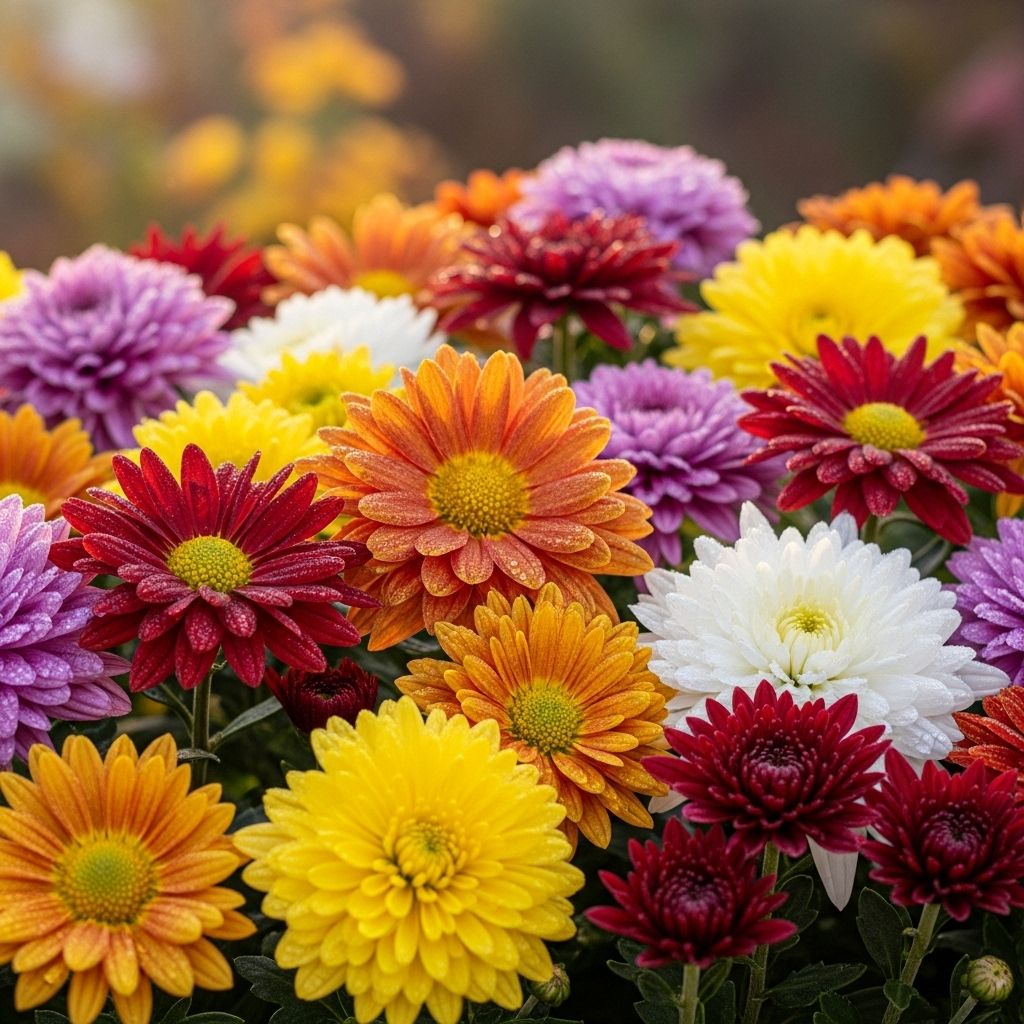Fall Chrysanthemum Varieties: 14 Stunning Mums For Your Garden
Discover the most beautiful and popular types of chrysanthemums to add dazzling color and texture to your autumn garden.

Image: HearthJunction Design Team
14 Stunning Chrysanthemum Varieties for Vibrant Fall Gardens
Chrysanthemums—lovingly referred to as mums—are autumn’s signature flowers. Their dazzling blooms, diverse forms, and robust growth habits make them a staple in fall gardens across temperate regions. Whether you want lasting color for your beds, cheerful cut flowers, or reliable potted decor, there’s a mum variety perfectly suited to your needs. In this comprehensive guide, we’ll explore 14 popular types of chrysanthemums, complete with descriptions, care tips, and ideas for beautiful fall displays.
Why Choose Chrysanthemums?
Few flowers rival the chrysanthemum’s ability to infuse late-season gardens with vibrant color. As other blooms fade, mums burst forth with abundant flowers in shades from soft pastels to rich jewel tones. They’re easy to grow, low-maintenance, and adaptable to a range of climates and garden styles.
- Long-lasting blooms: Mums often flower from late summer through frost, providing weeks of color when most other perennials are spent.
- Versatile planting: Perfect for beds, borders, containers, and even as annuals or perennials in different hardiness zones.
- Attract pollinators: Their prolific, nectar-rich blossoms support bees and butterflies late in the season.
- Excellent cut flowers: Many varieties hold up well in arrangements, adding texture and brightness indoors.
How to Use This Guide
This guide highlights 14 must-have chrysanthemum varieties for fall gardens, with details on each plant’s bloom color, growth habit, care requirements, and special features. Use this information to select mums that will thrive in your garden’s unique conditions and design stunning displays all season long.
Meet the 14 Favorite Chrysanthemum Varieties
1. Regal Mist Purple
| Type | Herbaceous perennial, incurve |
|---|---|
| Bloom Colors | Purple to fuschia |
| Sun Requirements | Full sun to partial shade |
| Height | 3–4 feet |
| Hardiness Zones | 5–9 |
This showy mum lives up to its regal name, producing dense, globe-shaped blooms in stunning purple shades. Regal Mist Purple is a top choice for border plantings thanks to its tall, upright growth and abundance of flowers from late summer through mid-fall. It also excels as a dramatic cut flower.
2. Red Rover
| Type | Herbaceous perennial, decorative |
|---|---|
| Bloom Colors | Bright red with yellow centers |
| Sun Requirements | Full sun |
| Height | 2–3 feet |
| Hardiness Zones | 5–9 |
Red Rover dazzles with eye-catching, daisy-like blooms. The intense red petals and bold yellow centers create lively contrast, making this variety perfect for mixed beds, borders, or autumn-themed containers.
3. Sheffield Pink
| Type | Herbaceous perennial, single flower |
|---|---|
| Bloom Colors | Salmon-pink |
| Sun Requirements | Full sun |
| Height | 2–3 feet |
| Hardiness Zones | 5–9 |
One of the most charming and graceful mums, Sheffield Pink features single daisy blooms in a soft, peachy-pink hue. Its relaxed, airy habit makes it an excellent choice for cottage gardens, mass plantings, or pollinator beds.
4. Chrysanthemum ‘Sweet Peg’
| Type | Semi-double flower |
|---|---|
| Bloom Colors | Pink-purple |
| Sun Requirements | Full sun |
| Height | 12–18 inches |
| Hardiness Zones | 5–9 |
This compact variety produces semi-double blooms in a stunning pink-purple shade, blooming from mid-October into early November. Its manageable height makes it ideal for borders or containers.
5. Pacific Chrysanthemum (Chrysanthemum pacificum)
| Type | Groundcover |
|---|---|
| Bloom Colors | Golden yellow |
| Sun Requirements | Full sun to partial shade |
| Height | 4–6 inches |
| Hardiness Zones | 5–9 |
Also known as silver and gold, this unique mum offers scalloped, white-edged foliage and clusters of golden yellow blooms. It makes a superb low-growing groundcover and is especially valued for its decorative leaves.
6. Chrysanthemum weyrichii ‘White Bomb’ and ‘Pink Bomb’
| Type | Single flower |
|---|---|
| Bloom Colors | White or pale pink |
| Sun Requirements | Full sun |
| Height | 8–12 inches |
| Hardiness Zones | 5–9 |
This species features charming daisy-like flowers with yellow centers, blooming from August until hard frost. The ‘White Bomb’ cultivar has white petals blushed with pink as they age, while ‘Pink Bomb’ offers delicate pink blooms. Both have compact form and attractive dark green foliage with purple stems.
7. Grandchild
| Type | Single flower, low-growing |
|---|---|
| Bloom Colors | Bright yellow |
| Sun Requirements | Full sun |
| Height | 12–18 inches |
| Hardiness Zones | 5–9 |
Compact and free-flowering, this variety bears single, bright yellow blooms on tidy, low plants. Its petite stature makes it perfect for the front of borders or mass plantings in smaller spaces.
8. Matchsticks
| Type | Decorative/spoon type |
|---|---|
| Bloom Colors | Red and gold |
| Sun Requirements | Full sun |
| Height | 18–24 inches |
| Hardiness Zones | 5–9 |
Distinctive for its spoon-shaped petals, Matchsticks delivers a unique look with bright red petals tipped in gold. It adds stunning texture to fall plantings and makes a standout display in containers or bouquets.
9. Bolero
| Type | Decorative |
|---|---|
| Bloom Colors | Burnt orange |
| Sun Requirements | Full sun |
| Height | 1–2 feet |
| Hardiness Zones | 5–9 |
Bolero features large, double blooms in rich burnt orange—a classic fall hue. Its bushy, rounded form is ideal for mass plantings and autumn displays, providing color that echoes the turning leaves.
10. Clara Curtis
| Type | Single/semi-double flower |
|---|---|
| Bloom Colors | Pink |
| Sun Requirements | Full sun |
| Height | 18–24 inches |
| Hardiness Zones | 4–9 |
This early-blooming mum produces delightful pink blooms with a yellow center, often appearing in late summer. Its reliable flowering and hardy nature make it an excellent perennial for diverse climates.
11. Mary Stoker
| Type | Single flower |
|---|---|
| Bloom Colors | Soft apricot |
| Sun Requirements | Full sun |
| Height | 2–3 feet |
| Hardiness Zones | 5–9 |
‘Mary Stoker’ impresses with masses of soft apricot blooms that brighten the garden from late summer right into fall. Its loose, informal growth pairs beautifully with ornamental grasses and other autumn perennials.
12. Single Korean (Chrysanthemum koreanum)
| Type | Single-flowered perennial |
|---|---|
| Bloom Colors | Yellow, orange, or pink |
| Sun Requirements | Full sun |
| Height | 1–2 feet |
| Hardiness Zones | 5–9 |
This hardy species produces cheerful, daisylike blooms in a range of colors. Its simple, classic look suits both contemporary and cottage-inspired gardens.
13. Morifolium (Garden Mum, Florist Mum)
| Type | Herbaceous perennial |
|---|---|
| Bloom Colors | White, pink, yellow, purple, red, bronze |
| Sun Requirements | Full sun |
| Height | 1–3 feet |
| Hardiness Zones | 5–9 |
The classic garden mum comes in a wide palette of colors and forms, with flowers ranging from small to large, single to double. They are prized for their reliability and are commonly used for seasonal displays as potted plants or border perennials.
14. Football Mum (Exhibition Mum)
| Type | Exhibition, incurved bloom |
|---|---|
| Bloom Colors | Various, typically bold tones |
| Sun Requirements | Full sun |
| Height | Up to 4 feet |
| Hardiness Zones | 5–9 |
These dramatic, globe-shaped mums are often showcased in floral competitions. Their enormous blooms and striking colors make them a focal point in the garden or in large floral arrangements.
Types and Forms of Chrysanthemums
Chrysanthemums are classified by their bloom form, which determines the arrangement and appearance of their petals. Here are some of the most common types:
- Incurve: Petals curve upward and inward, creating a domed or globe-shaped flower. Examples include ‘Regal Mist Purple’ and exhibition ‘Football Mums’.
- Decorative: Broad, often flat-topped blooms with multiple rows of petals, such as ‘Bolero’ and ‘Red Rover’.
- Single: Daisylike blossoms with a single layer of petals, as seen in ‘Sheffield Pink’ and Korean mums.
- Semi-double: Several rows of petals with a visible center, seen in ‘Sweet Peg’ and some Korean species.
- Spoon: Petals have spoon-shaped tips, imparting a unique look to varieties like ‘Matchsticks’.
- Pompon: Globular, button-like blooms, compact and highly decorative (noted in some heirloom and exhibition types).
Planting and Care for Chrysanthemums
- Sunlight: Mums thrive in full sun, though some tolerate partial shade, especially in hot climates.
- Soil: Well-draining, fertile soil is essential. Amend with compost before planting for best results.
- Water: Water deeply at the base to keep soil moist but not soggy. Avoid overhead watering to reduce disease risk.
- Spacing: Allow adequate space between plants for airflow to prevent fungal diseases.
- Pinching: For bushier plants and more blooms, pinch back the growing tips in early summer.
- Winter care: Mulch heavily after frost to protect perennial varieties in colder zones.
Best Uses for Chrysanthemums
- Garden beds and borders: Plant taller mums in the middle or back and low-growing types along edges for a vibrant display.
- Container plantings: Use potted mums for porch, patio, or entryway decoration—perfect for seasonal color swaps.
- Cut flowers: Many mums hold up well in bouquets; cut stems in the morning for best vase life.
- Mass plantings: Create colorful drifts by grouping several plants of one variety or mixing multiple colors and forms.
Frequently Asked Questions (FAQs)
Q: Are all mums perennials?
A: Many garden mums are perennials in USDA zones 5–9, returning each year with proper care. However, some types (like many florist or pot mums) are typically grown as annuals in colder climates.
Q: When is the best time to plant mums?
A: The best time to plant mums is in spring, allowing them to establish strong roots before blooming in fall. Fall planting is possible, but overwintering success is lower if roots have not formed well before frost.
Q: How can I get mums to rebloom?
A: Mums can sometimes be coaxed to rebloom by deadheading spent flowers and providing continued water and fertilizer. However, most bloom naturally in the fall and then go dormant for winter.
Q: What’s the difference between pot mums and garden mums?
A: Pot mums are grown specifically for decorative container sales, often as annuals and with pinched growth for compactness. Garden mums (also called hardy mums) are cultivated for landscape use and are generally better suited for perennial growth outdoors.
Q: Do mums attract pollinators?
A: Yes! Many single and semi-double flowered mums are excellent late-season food sources for bees and butterflies, especially as other blooms fade.
Conclusion
Mums come in a dazzling array of colors, forms, and sizes, offering a perfect option for every gardener seeking to brighten their autumn landscape. By exploring and planting some of these 14 top varieties, you’ll ensure weeks of vibrant color, texture, and interest in your fall garden year after year.
References
Read full bio of medha deb












